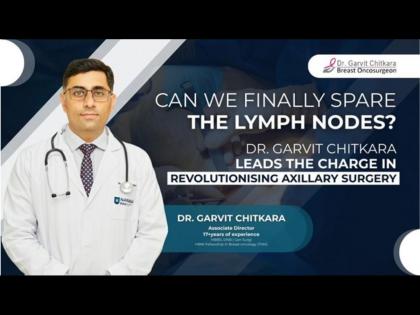Dr. Garvit Chitkara Leads the Charge in Revolutionising Axillary Surgery: Can We Finally Spare the Lymph Nodes?
By Impact Desk | Updated: September 2, 2025 18:34 IST2025-09-02T18:34:16+5:302025-09-02T18:34:26+5:30
Dr. Garvit Chitkara, a leading oncoplastic breast surgeon at Nanavati Max Super Speciality Hospital, Mumbai, is at the forefront ...

Dr. Garvit Chitkara Leads the Charge in Revolutionising Axillary Surgery: Can We Finally Spare the Lymph Nodes?
Dr. Garvit Chitkara, a leading oncoplastic breast surgeon at Nanavati Max Super Speciality Hospital, Mumbai, is at the forefront of transforming axillary surgery for breast cancer. He emphasizes a groundbreaking shift toward sparing lymph nodes to minimize patient morbidity while ensuring effective cancer treatment.
As the axillary lymph nodes are the first place where breast cancer spreads, their removal leads to preventing its further spread within the body. Additionally, the removal of lymph nodes aids in determining the stage of cancer and informs evidence-based decisions for its treatment. Hence, oncologists recommend its removal. For instance, if cancer is detected in more than three axillary nodes, the cancer has reached Stage II or III, and the treatment is suitably planned.
As a leading oncoplastic breast surgeon in Mumbai, India, Dr. Garvit Chitkara focuses on controlling cancer spread while reducing morbidity and optimizing aesthetics and function. Addressing the pivotal question, “Can we finally spare the lymph nodes?” and upcoming medical advances promoting surgical de-escalation of the axilla, Dr Garvit Chitkara shares his insights on the basis of compelling clinical evidence and professional experience in oncoplastic breast surgery. He anticipates a near future where axillary lymph node removal will be customized to prevent overtreatment and enhance quality of life for early-stage breast cancer patients.
But what is the reason for sparing the lymph nodes? The incidence of persistent swelling, shoulder stiffness, and long-term pain after the removal of lymph nodes makes it necessary to look for solutions to reduce patient morbidity. Hence, the consistent efforts to prevent their removal have accelerated in this direction, with encouraging outcomes.
Advances in cancer research are making it increasingly possible to limit, and sometimes avoid, axillary surgery for select patients. This evolving approach aims to maintain cancer control while improving quality of life, underscoring the importance of sparing lymph nodes.
Referring to the latest global trials, such as ACOSOG Z0011, AMAROS, and SOUND, which eliminate the need for complete axillary lymph node dissection (ALND), and enabling the treatment to focus on sentinel lymph node biopsy (SLNB) and modern radiation techniques.
The ACOSOG Z0011 trial found it safe to omit full ALND in patients with T1–T2 tumors, 1–2 positive sentinel lymph nodes, or those undergoing breast-conserving surgery, whole-breast irradiation, and systemic therapy. Dr. Garvit Chitkara notes this reduces lymphedema and shoulder dysfunction, especially in breast reconstruction.
Sentinel lymph node biopsy (SLNB) (https://pubmed.ncbi.nlm.nih.gov/40117118/) is now standard for treating node-negative breast cancer. This procedure identifies and removes key lymph nodes that are likely to be affected by cancer.
This biopsy helps stage cancer accurately and significantly reduces morbidity. However, the outcome of research on omitting SLNB in clinically node-negative women aged 70 or older with early-stage hormone receptor-positive, HER2-negative invasive breast cancer is still pending.
Patients who receive neoadjuvant chemotherapy (NACT) (https://pmc.ncbi.nlm.nih.gov/articles/PMC11869450/) and achieve nodal pathological complete response (ycN0) may avoid complete ALND. Oncologists then remove targeted and sentinel nodes to accurately assess residual disease.
Improved non-invasive imaging techniques, such as ultrasound and MRI, plus machine learning, increase the scope for preoperative detection of axillary lymph node metastasis. The new Superparamagnetic Iron Oxide (SPIO) tracer aids delayed SLNB and evidence-based decisions.
Oncoplastic breast surgeons, such as Dr. Garvit Chitkara, are dedicated to improving patients’ quality of life. They personalise axillary management based on patient condition and tumor biology and aim to minimise side effects such as lymphedema and pain.
Conclusion
Modern axillary surgery has undergone a revolution with a renewed focus on patient well-being and reducing post-operative challenges. Dr Garvit Chitkara looks forward to performing targeted lymph node removal and de-escalation of full dissections, which significantly reduce chronic arm swelling (lymphedema), persistent pain, numbness and other debilitating complications. This refined approach ensures that patients can expect to achieve optimal cancer outcomes, along with a smoother recovery and an improved, comfortable quality of life.
About Dr Garvit Chitkara
Dr. Garvit Chitkara is a distinguished breast cancer surgeon based in Mumbai, India, with expertise in breast cancer surgery and oncoplastic breast surgery. He has acquired a deep understanding of cancer genetics while studying at the Harvard Medical School.
With over 15 years of experience, including a stint at Tata Memorial Hospital, where he studied, practiced, and taught breast cancer surgery, Dr. Chitkara offers evidence-based, personalized, and comprehensive breast care. Patient-centric in his approach, he ensures to take adequate efforts to reduce patient anxiety and ensure optimal recovery. He is currently the Associate Director of Breast Surgical Oncology and Oncoplasty at Nanavati Max Institute of Cancer Care, Nanavati Max Super Speciality Hospital, Vile Parle West, and also practices at Orchid Clinic in Chembur.
Contact Dr Garvit Chitkara at
Orchid Clinic
405, Shiv Ashish Commercial Complex,
19th Rd, Chembur, Mumbai,
Maharashtra 400071
Nanavati Max Institute of Cancer Care, Nanavati Max Superspeciality Hospital, Vile Parle West, Mumbai
Open in app